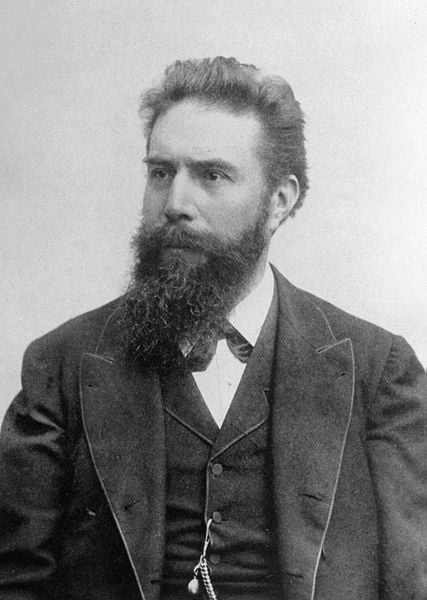*Image Credit: Wikimedia Commons One of the most important discoveries in history occurred on November 8, 1895 at the University of Wurzburg in Germany: Wilhelm Rontgen, a physics professor, was conducting a series of experiments with electricity and stumbled upon radioactive qualities a screen across the room — it glowed after he pushed a current through a vacuum tube. Thinking he might have discovered a new type of light, he dubbed them X-rays and spent the next several days living in his laboratory to determine their properties. Born in Amsterdam, Rontgen experienced difficulty getting into college — he had been expelled from school for withholding information from the dean of his boarding school. Forced to enter a technical school in Zurich, he completed training in mechanical engineering before receiving an appointment for doctoral studies at the University of Zurich. Bouncing around Germany after receiving his PhD, he was named the chair of the physics department at the University of Wurzburg in 1888. Rontgen spent much of 1895 testing the properties of electricity, experimenting with a variety of equipment to see how different materials — glass, cardboard, aluminum — affected the discharge of an electron beam. On November 8, 1895, he set up his lab to test how the thicker glass of a Hittorf-Crookes tube might affect the amount of light given off. Setting up a cardboard cover similar to those used in his previous trials, he set a second cover — this one coated with barium platinocyanide — off to the side to use after he made sure the cardboard was on tight enough. With the room completely dark, he fired an electrostatic charge through the tube, noticing a slight glow outside it. In an attempt to be sure his eyes weren’t deceiving him, he repeated the charging cycle several times. The same dim luminescence occurred with each pass. Confused, he struck a match to determine where it was coming from, realizing it was the barium platinocyanide screen. Stunned, he became obsessed with determining the properties of this new, unseen energy and named it “X-rays,” borrowing the mathematical letter assigned to unknowns. Two weeks later, he took an image of his wife Anna’s hand and changed medical science forever. Asking her to gently spread her fingers out on the screen, Rontgen produced was able to visualize the bones and a large black spot where her wedding ring rested. Terrified, Anna famously cried out, “I have seen my death!” Later, as he tested the deflective properties of various metals, such as lead, Rontgen noticed an image of his skeleton on the screen. Convinced he would be laughed out of academia if he discussed the project with his colleagues and was proved wrong, he continued working in secret. Just before the end of the year, on December 28th, Rontgen published his observations. Within months, his discovery had made the rounds throughout Europe. The Glasgow Royal Infirmary in Scotland had even set up an entire department dedicated to the use of the new radiation in diagnosis by the end of 1896. The following year, the technology was applied on the battlefield, locating shattered bones and shrapnel in wounded soldiers. For his work defining the properties of X-rays, Rontgen received the Nobel Prize in Physics for 1901. It would be nearly a decade before scientists discovered X-rays had harmful effects. Clarence Dally, one of Thomas Edison’s assistants, died of skin cancer in 1904 after working with the radiation. Without a full grip on the consequences, standards for protection did not come into force until the 1950s — by that time some stores in America had been helping people to see how well shoes fit by looking through an X-ray machine for decades! Now, as the field has advanced further, the application of X-rays has become key to a variety of industries. Progress in medical diagnosis and cancer treatment, not to mention uses in airport security and shipping, make Rontgen’s discovery one of the most widely adopted in history. Also On This Day: 1519 – Spanish conquistador Hernan Cortes is welcomed into Tenochtitlan by Aztec ruler Moctezuma II 1520 – A Danish invasion of Sweden leads to the deaths of 100 people in the Stockholm Bloodbath 1917 – The People’s Commissars grant leadership to Vladimir Lenin, Joseph Stalin and Leon Trotsky after the October Revolution 1923 – Adolf Hitler leads the Bier Hall Putsch, an unsuccessful attempt to overthrow the German government 1950 – The first jet-against-jet dogfight in history occurs during the Korean War between an American F-80 and two North Korean MiG-15s
November 8 1895 CE – Wilhelm Rontgen Accidentally Discovers the X-ray
*Image Credit: Wikimedia Commons One of the most important discoveries in history occurred on November 8, 1895 at the University of Wurzburg in Germany: Wilhelm Rontgen, a physics professor, was…
370
